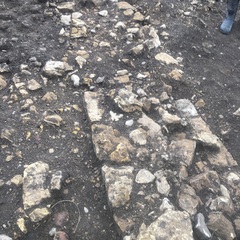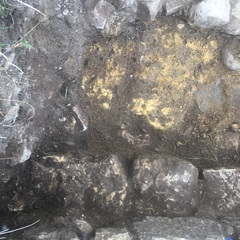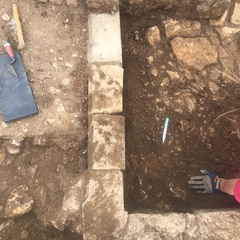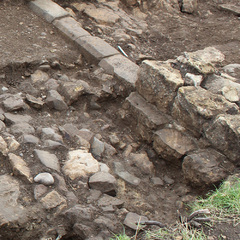Basic Information
- E-W aligned wall <1002> associated construction cut [1025] and backfill (1016) - part of building F14
Narrative
-
- F16 relates to the original form of E-W aligned wall <1002> with door lintel <1023>, its associated construction cut [1025] and construction backfill (1016). F16 was later remodelled, and incorporated with walls F15 and F17, into building F14.
-
- Josh Hogue
- 25-9-2020
-
- Wall F16 was exposed towards the north of the trench and truncated the remains of earlier wall foundations F10. It was E-W aligned and ran parallel with wall F15. Wall F16 comprised coursed squared limestone facing blocks bounded with coarse lime mortar and a rubble core (1002) and a door opening defined by chamfered threshold stones (1023). It was associated with construction cut [1025] and backfill (1016). Wall F16 measured 0.85m wide and survived 0.48 m high, with a 1.3m wide door opening. The eastern terminus of the wall fell within the confines of the trench. The western continuation of the wall continued beyond the limits of the excavation. Based on correlation with the geophysical survey results it survives at least 5.6m long. Wall F15 and Wall F16 were similarly constructed, thus suggesting that they were broadly contemporary in age. However, it appears unlikely that they were originally been part of the same structure and instead were only later remodelled and integrated to form a single structure. Wall F15 was wider and more substantial than F16, and it appeared likely to have been originally constructed as the southern outer curtain wall of the Bishop’s Place. Wall F16 in contrast was narrower and was associated with a door opening suggesting that it was part of a separate building.
-
- Indie Jago
- 16-10-2020
Dating Narrative
-
- Four potsherds of local glazed sandy ware (types 6 and 7) and Tees Valley ware were recovered providing a terminus anti quem of 1200-1300 AD for the wall.
-
- Indie Jago
- 16-10-2020



